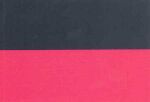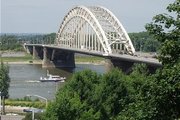Nijmegen
|
|
Template:Infobox Dutch municipality 2
Nijmegen (obsolete spellings: Nijmwegen, Nymegen, Nieumeghen — known in German as Nimwegen, French as Nimègue, and Spanish as Nimega) is a municipality and a city in the east of the Netherlands, near the German border.
| Contents |
Population centres
The municipality is formed by the city of Nijmegen, incorporating the former villages of Hatert, Hees and Neerbosch, as well as the Waalsprong, that lies to the north of the river Waal, including the village of Lent and the new suburbs of Nijmegen-Oosterhout and Nijmegen-Ressen.
The city of Nijmegen
| |||
International Four Days Marches Nijmegen
Nijmegen is famous for the International Four Days Marches Nijmegen also known as the"vierdaagse", an annual event starting on the third Tuesday in July, comprising four days of walking (distances ranging from 30 to 50 km a day), and the accompanying festivities, which have been drawing the largest crowds for any Dutch event in the past few years. [1] (http://www.4daagse.nl/frameset.asp?lan=eng)
Education
Nijmegen is host to a university, the Radboud University Nijmegen, which was founded in 1923 as the first catholic university in the Netherlands. The education and social work departments of the Hogeschool van Arnhem en Nijmegen school for higher level vocational training are also located in Nijmegen, as are that school's medical departments.
In addition to these institutions, there is also an intermediate level vocational school ( ROC Nijmegen ) and a number of high schools (Groenschool Nijmegen, Kandinsky College, Nijmeegse Scholengemeenschap Groenewoud (NSG), Stedelijke Scholengemeenschap Nijmegen (SSGN), Canisius College, Lindenholt College, the Stedelijk Gymnasium and Dominicus College). Of note is also Leefwerkschool Eigenwijs , which caters to students from all over the Netherlands who have been repeatedly expelled from "regular" high schools. Leefwerkschool Eigenwijs has its roots in the local activist movement of the early 1980's and is the only school of its kind recognized in the Netherlands.
History
The first mention of Nijmegen in history is in the 0s BC, when the Romans built a military camp on the place where Nijmegen was to appear; the location had great strategic value because of the surrounding hills, which gave (and give) a good view over the Waal and Rhine valley.
By 69, when the Batavians, the original inhabitants of the Rhine and Maas valley, revolted, a village called Oppidum Batavorum had formed near the Roman camp. This village was destroyed in the revolt, but when the revolt had ended, the Romans built another, bigger camp, where the Legio X Gemina was stationed. Soon after, another village formed around this camp.
In 103, the X Gemina was removed to Vienna, which was a major blow to the economy of the village around its camp. To soften the blow, in 104, Emperor Trajan gave market rights to the village, which officially became known as Ulpia Noviomagus Batavorum. Hence, Nijmegen. Few Roman remains are visible today; a fragment of the old city wall can be seen near the casino, and the foundations of the amphitheatre are traced in the paving of the present-day Rembrandtstraat. However, the Museum Kam, now part of the Valkhof Museum, has a large collection of Roman artifacts that have been dug up over the ages.
In the 4th century, Roman power decreased and Nijmegen became part of the Frankish kingdom. In the 8th century, Emperor Charlemagne built a castle in Nijmegen, which marked the start of an era of prosperity for Nijmegen.
Thanks to the Waal river, trade flourished and in 1230, Nijmegen was given city rights by Frederick II, Holy Roman Emperor. In 1247, the city was ceded to the count of Guelders as safety for a loan. The loan was never repaid, and Nijmegen has been a part of Gelderland ever since. This did not hamper trade; Nijmegen even became part of the Hanseatic League in 1364.
The arts also flourished in this period. Famous medieval painters the Limbourg brothers were born and educated in Nijmegen.
During the Dutch Revolt, trade came to a halt and even though Nijmegen became a part of the Republic of United Provinces in 1585, it remained a border town and had to endure multiple sieges.
In 1678 Nijmegen was host to the negotiations between the European powers that aimed to put an end to the constant warfare that had ravaged the continent for years. The result was the Treaty of Nijmegen that, unfortunately, failed to provide for a lasting peace.
In the second half of the 19th century, the fortifications around the city became a major problem; there were too many inhabitants inside the walls, but the fortifications could not be demolished because Nijmegen was deemed as being of vital importance to the defence of the Netherlands. When, however, events in the Franco-Prussian war proved that old-fashioned fortifications were no more of use, this policy was changed and the fortifications were dismantled in 1874. The old castle had already been demolished in 1797, so that its bricks could be sold.
Through the second half of the 19th century and the first half of the 20th century, Nijmegen grew steadily. The Waal was bridged in 1878 by a rail bridge and in 1936 by a car bridge, in 1923 the current Radboud University Nijmegen was founded and in 1927 a channel was dug between the Waal and Maas rivers.
In 1940, the Netherlands were invaded by Germany with Nijmegen being the first Dutch city to fall into German hands. On 22 February, 1944, Nijmegen was heavily bombed by American planes, causing great damage to the city centre. Allegedly the pilots thought they were bombing the German city of Kleve, although it has also been claimed to have been a deliberate act. The NIOD announced in January 2005 that its study of the incident confirmed that it was an accident caused by poor communications and chaos in the airspace. Over 750 people died in the incident. During 1944, the city saw heavy fighting during Operation Market Garden.
In recent history, one of the darkest pages was written in the early 80's. On February 23rd 1981, the Nijmegen Police Department, together with the Dutch Army stormed a squatted housing block, the Piersonstraat and Zeigelhof in Downtown Nijmegen. Using 200 Riotvans, 3 Leopard MBT Armoured Vehicles, 3 Armoured Personel Carriers, a Helicopter, 1200 policemen and 750 members of the Armed Forces they evicted the squatters and demolished the block, while clouding the entire area in Teargas and CX Gas. This had an enormous backlash into local politics because the city government wanted the squatters out to build a parking garage, whereas most of the population wanted affordable housing in the area. In the weeks prior to these events the squatters managed to get more popular support than the mayor, and when the local government reacted with this extreme amount of violence against its own population, they lost all support among the population.
As to this date Nijmegen is still known as Havana on the Waal among Right-wingers. The Socialist Party, the Green Party and Labour have a solid two-third majority in City Council, making Nijmegen the only major city in The Netherlands with a Left-wing government.
The current mayor is Mrs Dr Guusje Ter Horst.
Museums in Nijmegen
- Africa Museum (http://www.afrikamuseum.nl/) (African art and culture)
- biblical open air museum (http://www.bijbelsopenluchtmuseum.nl/) (ancient middle eastern buildings)
- Valkhof museum (http://www.museumhetvalkhof.nl/) (roman history and modern art)
- Velorama (http://www.velorama.nl/) (bicycle museum)
Famous people from Nijmegen
- Petrus Canisius, saint
- Vincentius von Aernsberghen, saint
- Eddie van Halen, rock musician
- Henry VI, Holy Roman Emperor
- Limbourg brothers, medieval painters
- Maud Mulder, popular singer
- Frank Boeijen, popular singer
Miscellaneous information
- Nijmegen is twin town (Sister City) to the cities of Pskov in Russia and Masaya in Nicaragua.
- The gothic rock band Clan Of Xymox was founded in Nijmegen in 1983.
External links
- Official site (http://www.nijmegen.nl/)
- Noviomagus.nl (http://www.noviomagus.nl/)
- Basic data from State Almanac (http://www.sdu.nl/staatscourant/gem/gem344g.htm)
- Statistics in Dutch (pdf) (http://www.cbs.nl/nl/publicaties/publicaties/nederland-regionaal/gom/2002/pdf/n/nijmegen.pdf) - with (towards the end) a map showing the neighborhoods and (a few pages further) the population figures etc. as well as the grouping into quarters
- Map (http://www.novio.nl/vervoer/netkaart/NOVIO%20kaart%20Dec2003.pdf)
- Pictures (http://www.happytown.nl/Nijmegenfoto/nijmegen.htm)
Template:Province Gelderlandda:Nijmegen de:Nimwegen fr:Nimègue li:Nijmege nl:Nijmegen ro:Nijmegen wa:Nîmegue


